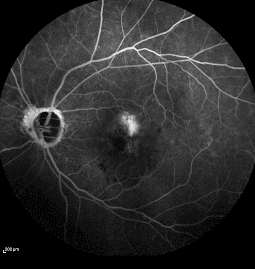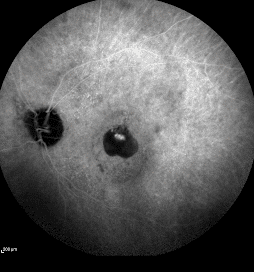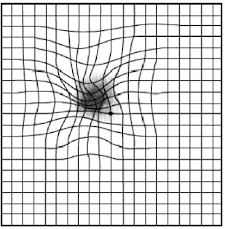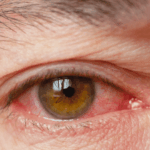Central Serous Chorioretinopathy (CSCR) is a retinal disorder where fluid accumulates beneath the macula, the area of the retina which is responsible for central vision. The fluid leakage comes from a layer of tissue under the retina, called the choroid. It often results in blurry or distorted central vision.

The exact cause of CSCR is not fully understood, but it is believed to involve a combination of factors, including disturbances in the choroidal circulation, stress, and steroid use. The condition is typically unilateral (affecting one eye), although it can sometimes affect both eyes.
Who is at Risk for CSCR?
CSCR is most commonly seen in adults between the ages of 30 and 50, with men being more frequently affected than women. Some risk factors include:

- Stress
- Steroid Use. Both systemic and topical steroids are believed to alter the permeability of the blood vessels in the choroid, leading to fluid leakage.
- Underlying Health Conditions. For example, hypertension.
- Genetics
- Age and Gender. CSCR is 6 times more commonly found in men, particularly those in their 30s to 50s.
Symptoms of CSCR
CSCR will affect vision and may make reading, driving, or recognizing faces more challenging.
- Blurry vision
- Visual Distortions. Straight lines may appear curved or wavy.
- Micropsia. Patients may perceive objects smaller than they actually are.
- Dark Spots in Vision
- Color Perception Changes
How Is CSCR Diagnosed?
In OasisEye Specialists, diagnosis of CSCR is aided by the following procedures:
Optical Coherence Tomography (OCT): This imaging technique provides detailed cross-sectional images of the retina, showing if there is any fluid accumulation. OCT angiography (OCTA) is a high resolution imaging technique that can detect vascular abnormalities, especially in chronic CSCR cases.


Fundus Fluorescein Angiography (FFA): A dye is injected into the bloodstream, and a special camera captures images of the retina to detect abnormal blood vessel leakage or areas of fluid buildup.


Indocyanine Green Angiography (ICGA): Similar to FFA but ICGA focuses on detecting the leakage of fluid in the choroid layer.


Amsler Grid Test: Patients may be asked to look at a grid of straight lines. Distorted lines or blind spots can help diagnose visual disturbances caused by CSCR.

Treatment Options for CSCR
In most cases, CSCR resolves on its own without the need for medical intervention. However, in persistent or recurrent cases, treatment may be necessary to reduce the risk of long-term vision damage. Some treatment options include:
- Steroid Avoidance.
- Laser Photocoagulation: This technique could seal the leakage point and hastens the resolution of subretinal fluid.
- Photodynamic Therapy (PDT): This treatment uses a light-sensitive drug called verteporfin and laser to activate the drug. It can close abnormal blood vessels in the choroid and reduce fluid buildup.
- Anti-VEGF Therapy: In some cases, drugs that block vascular endothelial growth factor (VEGF), which promotes abnormal blood vessel growth, may be used to reduce fluid accumulation.
Prevention of CSCR
While there is no guaranteed way to prevent CSCR, there are several strategies to reduce risk:
- Stress Management. Regular exercises are recommended.
- Avoid Steroids.
- Maintain a Healthy Lifestyle. For example, a balanced diet.
Conclusion
Central Serous Chorioretinopathy is a serious yet often manageable eye condition that can impact vision. If you experience symptoms like blurred or distorted vision, it’s important to seek the advice of an eye care professional to ensure early intervention and preserve your vision.
The Retina Specialists in OasisEye Specialists include Dr Kenneth Fong Choong Sian, Dr Manoharan Shunmugam, Dr Wilson Wong Jun Jie, Dr Wong Hon Seng and Dr Rajasudha Sawri Rajan from Kuala Lumpur; Dr Teh Wee Min from Seremban; Dr Ling Kiet Phang from Johor Bahru; and Dato’ Dr Haslina Binti Mohd Ali (D.S.D.K) from Penang.
FAQs
Most cases are temporary and resolve on their own within 1 to 3 months. However, chronic or recurrent CSCR can lead to permanent vision damage if not managed properly.
Yes. Recurrence is common, especially in those with ongoing stress, steroid use, or poor sleep hygiene. Repeated episodes may lead to vision loss.
Total blindness is very rare, but central vision loss or permanent visual distortion can occur in chronic or untreated cases.
No. CSCR is typically painless. Any pain should be investigated further, as it may indicate a different condition.
CSCR is not directly inherited, but genetic susceptibility may play a role. Having a first-degree relative with CSCR may slightly increase your risk.






